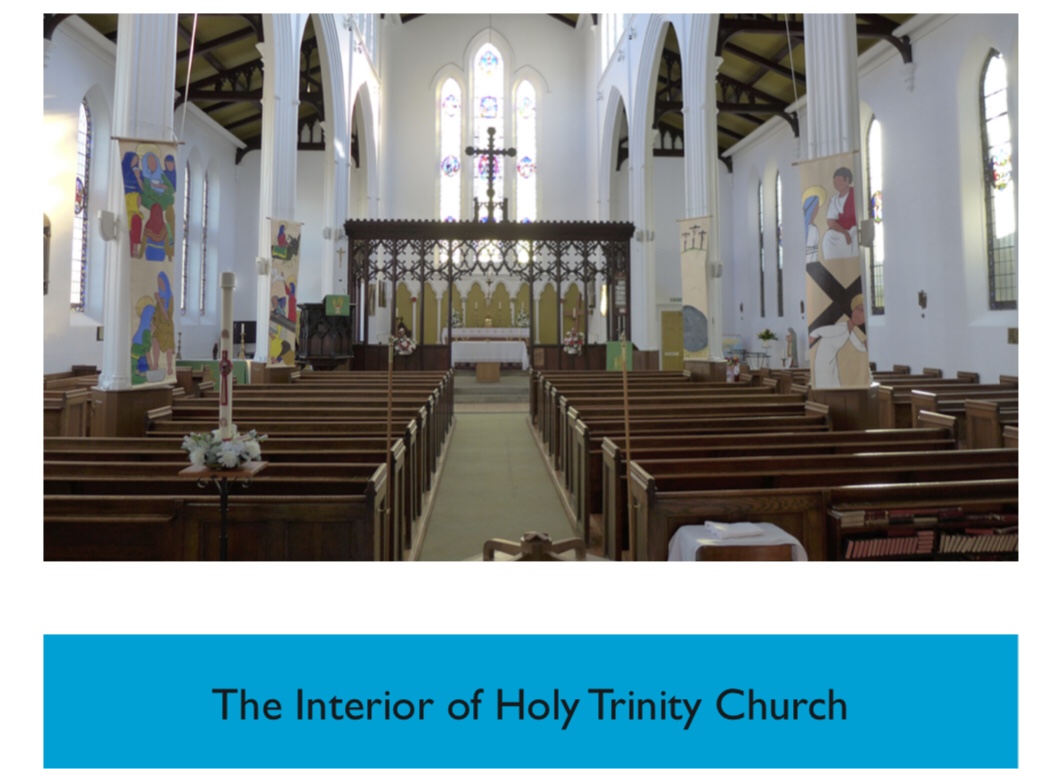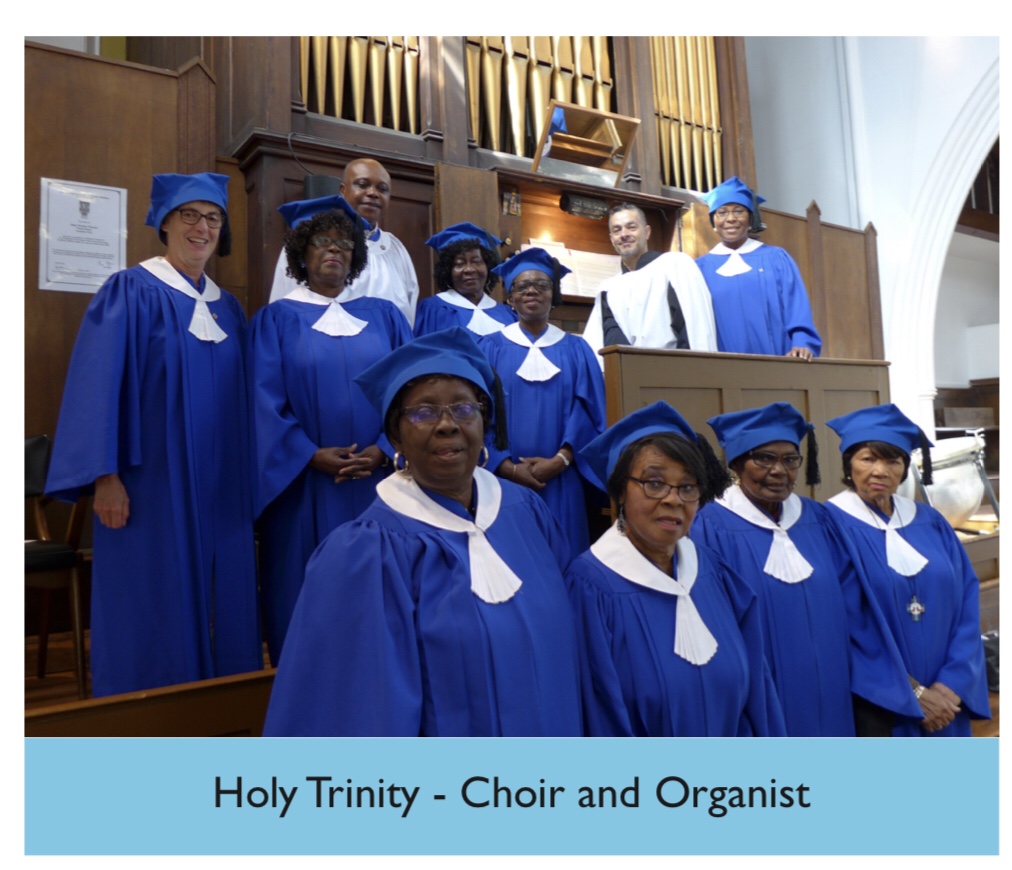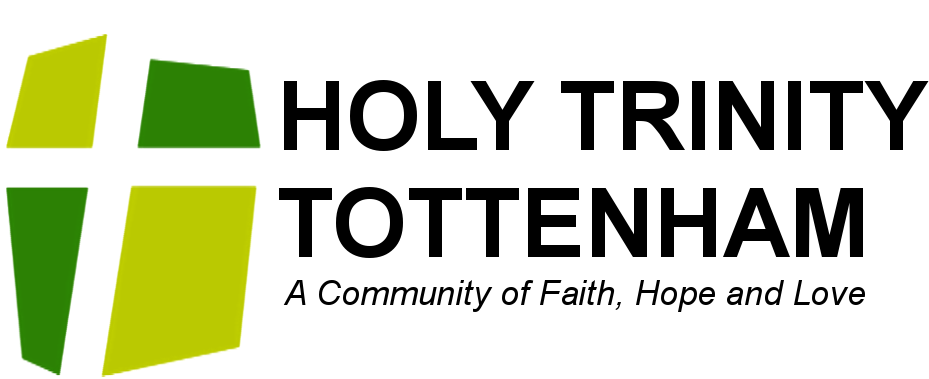Holy Trinity Tottenham Organ Fund Appeal
holy-trinity-organ-e-print-version.pdf
HOLY TRINITY CHURCH,TOTTENHAM Please help us to restore our historic Father Henry Willis Pipe Organ Built in 1859, in a case by John Gray dating from 1838.
We have raised £45000 by Parish Fund Raising over the past three years but more help is urgenty needed.
Over £130,000 is still required.
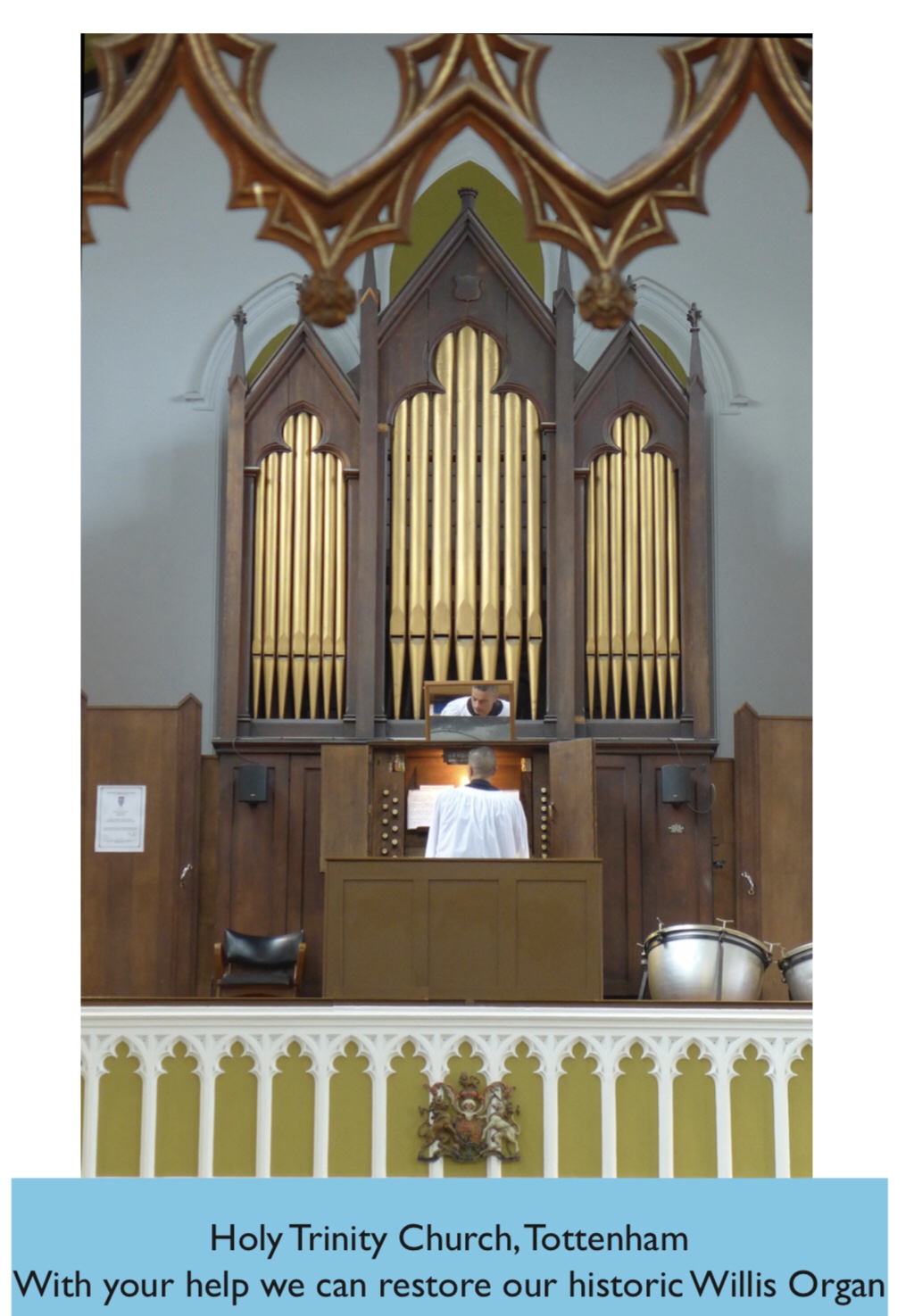
This write-up gives full information about the history of the organ and the work which is required to restore the instrument to full working order. It explains why we have to simultaneously restore the west window. It gives estimates of the cost of the work.
We also provide background information on the history of our church and its importance to our community.
Music is an inspirational part of our church life and worship.
Our main weekly service, Parish Eucharist on Sundays (at 10am), is led by the organ and our fully robed choir. This service becomes the Family Service and ‘Gospel Sunday’ on a regular pattern each month. The organ and choir play no less a part in these services but adopt different styles of music to reflect the nature of the service. The organ lifts our eyes to heaven; it inspires us to continue our pilgrim journey; it consoles us as we face our own mortality; it expresses our joy; it comforts us and gives us hope for a peaceful world. The organ speaks direct to our inner most soul.
Beyond our usual worship services we host the Civic Annual Rembrance Day service and a candle lit service of lessons and Christimas carols with cameos from the choir and organ. We also host various community meetings and ecumenical gatherings.These include hustings at election time, social justice consultations and civic conferences. For example, we recently hosted key stakeholders involved in the planning and delivery of new Housing Schemes in Tottenham. This was attended by the Area Bishop – the Rt Rev’d Rob Wickham.
Our organ is a fine early instrument by Henry Willis (Father Willis). It is said to be one of only two early Willis small organs still in working order. (The other is to be found at St Mildred’s Church, Whippingham, Isle of Wight,installed on the instructions of QueenVictoria c1857 and enlarged by Willis in 1861. Osbourne House, a favourite home of Queen Victoria’s, is in the parish of St Mildred.) Our organ was built in 1859 but is housed in a case made by John Gray in 1838. In other words our organ has been in continuous use for nearly 160 years. It is not surprising, therefore, that it requires a complete overhaul.
Our organ is historically significant. By 1859 Willis was the ‘star’ organ builder in Britain, his fame founded on his organ for the Great Exhibition (1851) so admired by HM Queen Victoria and HRH Prince Albert.
No wonder Her Majesty commissioned Willis to build an organ for her parish church in 1857. It is astounding to realise that two years later a Willis two-manual organ was installed in our Church!
Our forebears achieved their goal to get the foremost organ builder of their day to build the organ in their church. We have a duty to make sus- tain their achievement by restoring this remarkable instrument.
Historical Background
Henry Willis was unrivalled in his skill and genius in organ building. He was an accomplished organist. He understood the organ as an organist. Willis was painstaking in his approach to every detail of the instrument. He paid attention to every aspect of organ production. Small in stature he was renowned for his boundless energy. He was an inventor and an engineer. No wonder his organs have such a distinctive bright, lyrical sound.
The Dictionary of National Biography’s (DNB) entry onWillis comments, “The rich and clearly focussed colours at every dynamic level of a Willis Organ reflected the insights he gained into nineteenth century trends in orchestral instruments and orchestration.” He was an accomplished double-bass player.
The DNB continues,“He had his very own systems of pipe scaling and voicing in both individual flute ranks and choruses, a distinctive accord of diverse tone colours with a balance of harmony and clarify of texture.”
Henry was born in North London on 27th April 1821, son of Henry Wil- lis a local builder. (Henry Willis the organ builder is often referred to as Henry Willis 1.) In 1837, at the age of 14, Henry was articled to the company of John Gray & Son, the foremost organ builder in London at that time. He completed his seven year apprenticeship in 1842.
During this time he is said to have invented a manual-pedal coupler that he used throughout his career.
Other inventions were to follow throughout his career.
Willis’s biographer, W L Sumner, reminds us that until the beginning of the nineteenth century a three manual organ would have a properly developed light diapason chorus on the great organ, a smaller chorus in the choir organ and a short compass swell-organ with a few stops.
As a rule there were no pedals. Willis’s inventiveness and drive helped develop the organasweknowittoday. He was particularly known for his use of the radiating pedal boards.
After completing his apprenticeship Willis went to work for Wardle Eastland Evans, a violinist and ingenious instrument maker based in Chelten- ham. Evans specialised in reed instruments of the harmonium type but he was also an organ builder and kept a music shop.
Henry returned to London in 1845 and set up his own firm of organ builders. His first notable task was to rebuild the organ at Gloucester Cathedral in 1847. Willis was to go on to construct grand organs in many of the greatest cathedrals in our land including St Pauls, Durham, Edinburgh, Glasgow, Lincoln, Salisbury, Wells, and Winchester as well as the Royal Albert Hall, St George’s Hall, Liverpool, Blenheim Palace and Haringey’s very own Alexandra Palace.
Later in life Willis himself said that his work at Gloucester Cathedral was his “stepping stone to fame”. Not surprisingly other commissions in the West Country followed. During this time Willis met the Revd. Dr John Baron, Rector of Upton Scudamore, near Warminster. Baron thought that small churches needed small and simple pipe organs, rather than use a harmonium, the only practical alternative. Baron wrote a book on this theme. Willis made the construction of small organs a special branch of his company. Most of these ‘Scudamore organs’ only had three stops, open and stopped diapason with a principal and 18 coupled pedals and projected a mere 12 inches from the wall of the platform on which they stood. Ourorganisnota‘Scudamoreorgan’,itislargerineveryrespect (it fills Gray’s very large case) but it must have come from Willis’s small organ works at 119 Albany Street, Regents Park.
Sumner tells us that “Willis hardly ever left his name-plate on an organ of this early period, because he insisted that the tone of the organ revealed its maker, but some of his organs bore a brass plate engraved Henry Wil- lis, in old English lettering.” Our organ has such a plate.
Once back in LondonWillis became organist at Hampstead Parish Church and Islington Chapel of Ease. He had been the organist at Christ Church, Hoxton whilst serving his apprenticeship, a job he won by being able to play the ‘Hallelujah Chorus’ from Handel’s ‘Messiah’. ‘Messiah’ was a fa- vourite of Willis. It is worth nothing that Willis often gave the opening recital on his newly built organs or, failing that, played at the first service.
Only three English organ builders have been affectionately called ‘Father’: John Howe (c1526 to c1571), Bernard Smith (1630-1708) and Henry Willis 1 (1821-1901).
On 12th June 2010 the organ of Holy Trinity Church Tottenham was awarded a certificate Grade II by the British Institute of Organ Studies. The organ is therefore listed in the Institute’s Register of Historic Pipe Organs as being “an instrument of importance to the national heritage and one deserving careful preservation for the benefit of future genera- tions.”
Our Willis organ is a monument to the finest organ builder in the Victorian era. Its sound is its breath of life. Our Organist, Mr John Khwaja, is adept at getting the best out of the instrument (he has been playing this organ for 20 years). So too is our Assistant Organist, Mr Joduni Okrafo- Smart. But there will come a time when the organ will fail, worn out by old age.
We have had the organ serviced at regular intervals by Bishop & Son, organ builders,. Because of its age many notes are unplayable and stops unusable. Full restoration and rebuilding is required. Our predecessors bequeathed us the finest small organ of its day. We own it to our succes- sors to leave them a similiar legacy: our historic Willis organ in full voice.

Work to be carried out Report by Bishop & Son, Organ Builders Established 1795
Bishop & Son, organ builders, have looked after our organ for many years on a ‘care and maintenance’ basis. They have given us a comprehensive report on the work our organ now requires.
“The organ has suffered from many evils over its life time. Firstly, the in- strument is considerably dirty. This is usual after so many years of service, but is undoubtedly worse due to the high volume of traffic pollution in the area. Further to this and the general wear and tear expected in an organ mechanism, rain water has fallen into the organ case and caused considerable damage beyond normal expectations. We believe that after examining all of the relevant points, the time has now come when com- plete historic restoration of the organ must be considered.”
Many notes and stops malfunction.The blower may need attention and there could be serious wood worm infestation in the case (which is now180 years old).
General
The organ will be dismantled and all dust and dirt removed from the in- terior and mechanisms.
Manual Keyboards
All the keys on the two manuals will be disconnected from the action, taken out and referred to the specialist keyboard maker to have the playing surfaces re-covered as necessary and polished. New cloths and baizes are to be made and fitted. The balance and oval bat pins are to be cleaned.The oval bat pins are to be adjusted to take up wear. The mortices are to be re-brushed and regulated.
Pedalboard
The pedals are to be taken up.Worn surfaces are to be pieced out with hardwood to restore their original levels. Rails are to be re-felted and re-brushed to reduce noise and take up false action. Pins and springs are to be cleaned and lubricated. Frames and keys are to be re-dressed with linseed oil.
Drawstop action
The whole drawstop action is to be dismantled and overhauled, bearings and centres of levers and trundles to be cleaned of corrosion and re- greased, worn centres and bushes to be replaced. All ironwork is to be repainted. False action at the slide ends to be taken up. Composition rod blocks to be re-felted and all rods to be re-bushed in the jambs. Draw- stop labels are to be cleaned off and the engraving re-filled with black lettering. New rods to be made and fitted where the existing rods are too worn to be re-used.
Key, pedal and coupler action
The key, pedal and coupler action will be removed and completely over- hauled, backfall and square beams to be re-centred with phosphor bronze and graphited to ensure freedom of movement. Rollers to be taken from their boards, re-bushed and re-centred where necessary and the metal rollers re-blacked, Defective tracker work will be replaced and any iron wires replaced with new replicas made from phosphor bronze. New regulating leather buttons and cushioning cloths to be fitted.
The pneumatic primary motors to the pedal organ to be renewed and the valve work also to be replaced. The pedal touchbox and pneumatic relay to be extensively dismantled for complete overhaul. All leather movements, regulating buttons and cushioning cloths to be replaced. Re- turn springs to be cleaned off, regulated and lightly oiled. The relay stop action slides to be checked against their bearing surfaces for truth, lubricated with graphite and carefully tested to ensure they are sound.
Extra scoring to be provided to prevent running notes.
Pneumatic tubing to be renewed using existing tubing where possible and new equivalent as required, this all to be run through the organ using supports to prevent strain over time.
Console and casework
The front or prospect pipes to be carefully restored to remove bruis- ing and deformation.The woodwork to be repaired and re-finished to improve the appearance of the casework. The whole then to be treated with linseed oil to revive the timber and improve its appearance. The console to be carefully inspected and restored. All interior surfaces of the console to be hand French polished.
Soundboards
The soundboards will be removed for complete overhaul. These to be extensively dismantled and carefully inspected. The table to be inspected for splits and shakes and these to be secured using glue and screws. The note bars to be flooded with ‘scotch’ glue to prevent ‘runnings’. The can- vassing to be renewed. Pallets to be stripped off, checked for truth then to be recovered using best quality lambs wool felt and sheepskin. The pallets ten to be carefully glued to the note bars. The pallet springs to be cleaned, carefully regulated and their coils lightly coiled.The exterior woodwork to be re-finished by hand and the whole to be re-assembled, carefully regulated and tested.
Swell Box and Action
The interior surfaces to be made sound and finished with hard gloss white paint for maximum sound reflecting properties. Centres of shut- ters, lift rods and levers etc to be cleaned and lubricated.
Bellows, wind trunks and conveyances
The bellows reservoir to be removed for complete restoration. All leath- erwork to be completely stripped off and discarded.The woodwork of the reservoir to be carefully examined and any splits or shakes to be se- cured. The whole to be re-leathered using best quality white sheepskin. The control valve to be opened up and thoroughly cleaned, the leather blind to be renewed and the tensioning tape to be replaced. Bedding of collars to all trunks to be renewed and metal conveyances rounded out. Any defective joints to be made sound. Blower bearings to be checked.
Pipework
All the pipes, both wood and metal, to be carefully cleaned, each pipe to receive individual attention. Metal pipes to be rounded out and repaired as may be required. Wooden pipes to be likewise repaired, stoppers re-packed and lubricated, splits glued and any loose feet, caps or shades secured. Reeds to be taken apart, shallots re-burnished, tongues cleaned, broken or ill-fitting wedges replaced, tuning springs cleaned and freed in their blocks.
Woodworm
Opportunity to be taken while the organ is dismantled to examine care- fully all the woodwork and to treat infestation liberally, any timber-work seriously damaged to be replaced as required.
Finishing
When the organ has been re-assembled and actions adjusted carefully, the pipes to be replaced and their speech re-set and regulated against the prevailing acoustic conditions of the church to ensure correct balance of tone. Finally, the whole to be accurately tuned.


Our historic church building
Holy Trinity Church Tottenham is a Grade II listed church completed in 1830 to a simple but elegant design of James Savage. It is a plain building comprising a nave, sanctuary, and aisles. When new it was highly praised, although the crocheted pinnacles (now removed) were condemned as ‘Perpendicular blemishes’ in an otherwise austere work in the early English style.
The Gentleman’s Magazine of 1831 reported:“The Chapel may rank among the best structures in Pointed style which we have met within the course of our surveys. It is situated on the west side of the High Road at the en- trance to the village, and not far from the well known Seven Sisters.” (A grove of seven mighty trees).
“The materials are brick and stone … In the adoption of the early or lan- cet style of architecture, Mr Savage has displayed good taste and better taste in keeping, with some exceptions, to one style in his building. The plan shows a nave, or body with side aisles, which at their extremities fall short of the central part of the building, making a small chancel at one extremity, and a space for vestibules.”
The church is said to have been modelled on the Chapel of Kings College, Cambridge. This was an appropriate design bearing in mind that our church was built as a chapel of Tottenham Parish Church, All Hallows., Bruce Castle. It is no surprise that as a consequence, the church was originally referred to as the Trinity Chapel.
It was built on part of Tottenham Green given by the then Lord of the Manor of Tottenham, and former Lord Mayor of London, Sir William Curtis Bt. (1752-1829) to be used for ecclesiastical purposes for ever.
The original cost of the building was met by public subscription and Par- liamentary grant authorised under the Church Building Act 1824, for ‘new churches to cater for the needs of the new industrial towns.’ The population in the area around Tottenham Green was growing and it was thought necessary to provide folk with an opportunity to worship with- out travelling to the Parish Church.
In other words our church is the second oldest church in Tottenham. It became a ‘District Chapelry’ in 1844 and ‘perpetual curates’ were thereafter appointed by the Vicar of Tottenham. This meant that it now officially served the area around Tottenham Green in its own right.
The Parish of HolyTrinity was created on 10th December 1884.
Description of Holy Trinity Church
Holy Trinity is a one-cell church, with a nave, sanctuary and two aisles built of yellow stock brick. (The brickwork was cleaned in 2005.) It is traditionally orientated east to west, built in the early English style. There are five bays with windows in their north and south aisle walls. Each aisle window has an oval shaped panel of stained glass which tells the story of the text set into the base of the window. The windows in the bays at the west end of the nave are blank.
The eastern nave bay is screened to form the chancel. A short sanctuary extends eastward of this.The west bay is filled by a gallery and the aisles below are filled in to provide a vestry and a quiet room.
Specific to this appeal it must be noted that the Willis organ in the Gray case are in the centre of the gallery. They are a key feature in our His- toric England historic building listing.
Each gable contains a large triple lancet windows flanked by double lancet window.The three lancet window in the east gable,which overlooksTot- tenham High Road, is of stained glass, the smaller double lancet windows are of plain glass. The west window and its flanking lancets are all of plain glass. There is a clock in the east gable which was restored in 2005.
Each bay in the nave is topped by three small lancet clerestory windows to admit light and flesh air.
At all four corners of the nave roof crocheted pinnacles in Bath stone 16
were built. These originally had open drums and stone spirelets but were removed to parapet level in 1985. There are high gables at both east and west end. The aisles are covered with identical lower-pitched roofs. There are smaller Bath stone pinnacles on each of the four outer corners of aisle roofs. These were restored in 2004.
West Window
This appeal must include the restoration of the West Window (Three Lancets of leaded lights in steel frames and mullions).This is necessary to prevent further water penetration of the organ. The organ case abuts these windows. If funds permit we will also restore the two double lan- cet windows.
Setting
Thanks to Sir William Curtis’s foresight the church occupies a command- ing position on Tottenham Green, adjacent to Tottenham High Cross, the former town well,the former historic Swan public house,TottenhamTown Hall, Tottenham Bus garage and Tottenham Green Sports Centre. From the south the church can be seen from a considerable distance, especially during the winter when the trees on Tottenham Green are leafless. This view is valued by the local community and passers-by alike especially on days whenTottenham Hotspurs are playing at their home ground further north along the High Road.


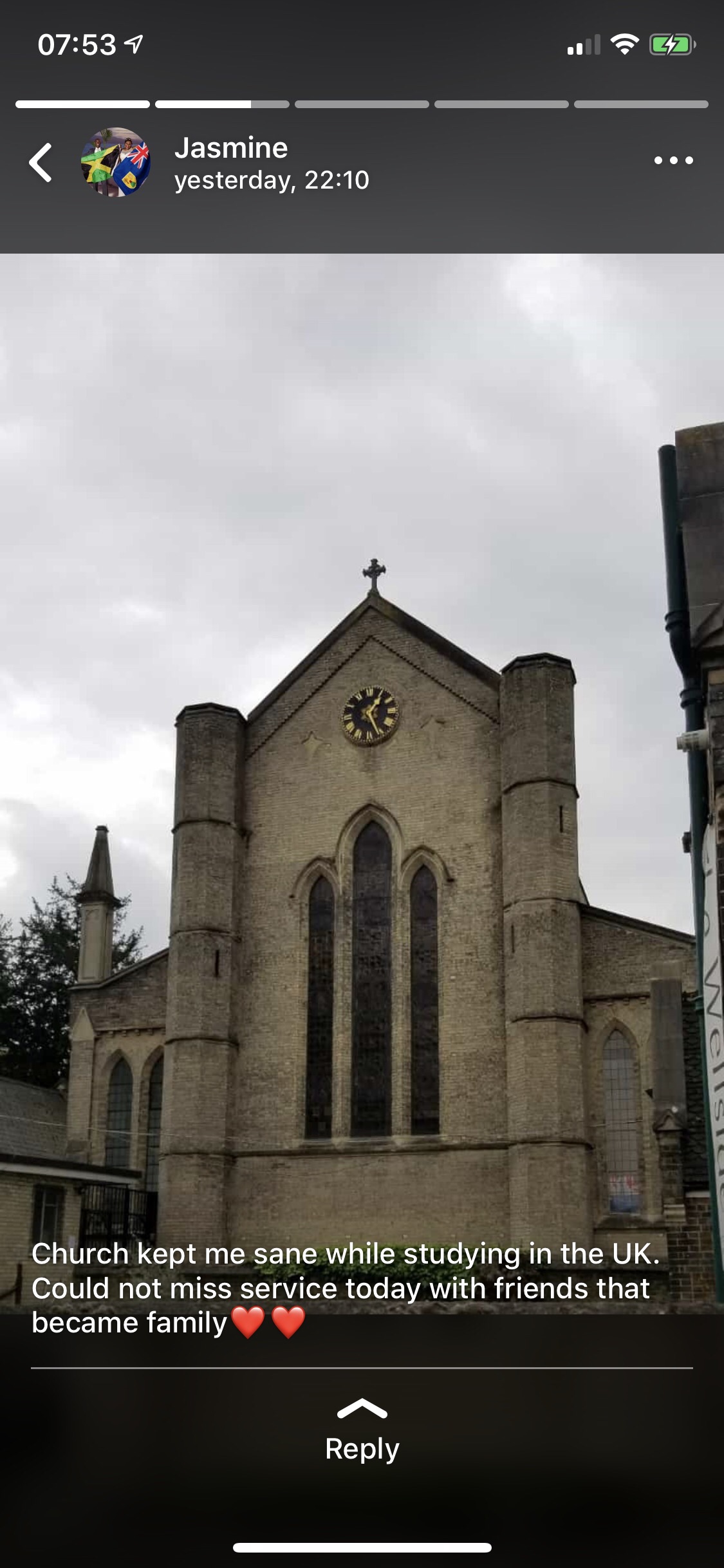

It is worth noting that the High Road is, in fact, a Roman road, the Ermine Way. Izaak Walton’s famous 1653 discourse on fishing and life, The Com- pleat Angler, starts and finishes at Tottenham High Cross.* Our church is only 30 yards from the High Cross. The view of our church, old school (built in 1849) and the old pump from the High Cross are a ‘preserved view’ of historical significance.
General information
HolyTrinity is a densely populated parish.The parish population is c18,000 (2015 official figures). In 2017, the Diocese of London, formally established a worshipping community (St Francis at The Engine Room) to cater for influx of another 12,000 people into the parish in a new purpose built residential estate – The Tottenham Hale Village. The St Francis worshipping community and the environs of Tottenham Hale Village will, once legal procedures are finalised, eventually emerge as a new parish. However, there is no doubt that our parish population will continue to grow as the local authority already has plans for the creation of more new residential houses within the parish boundaries. This is to address the pressing housing crisis in London.
The Electoral Register at Holy Trinity, Tottenham, averages 130. The median age of attendees at Sunday services is 40-50; the mid-week congregation is smaller and older. About 30 children and some l0 to 15 youths attend our services.
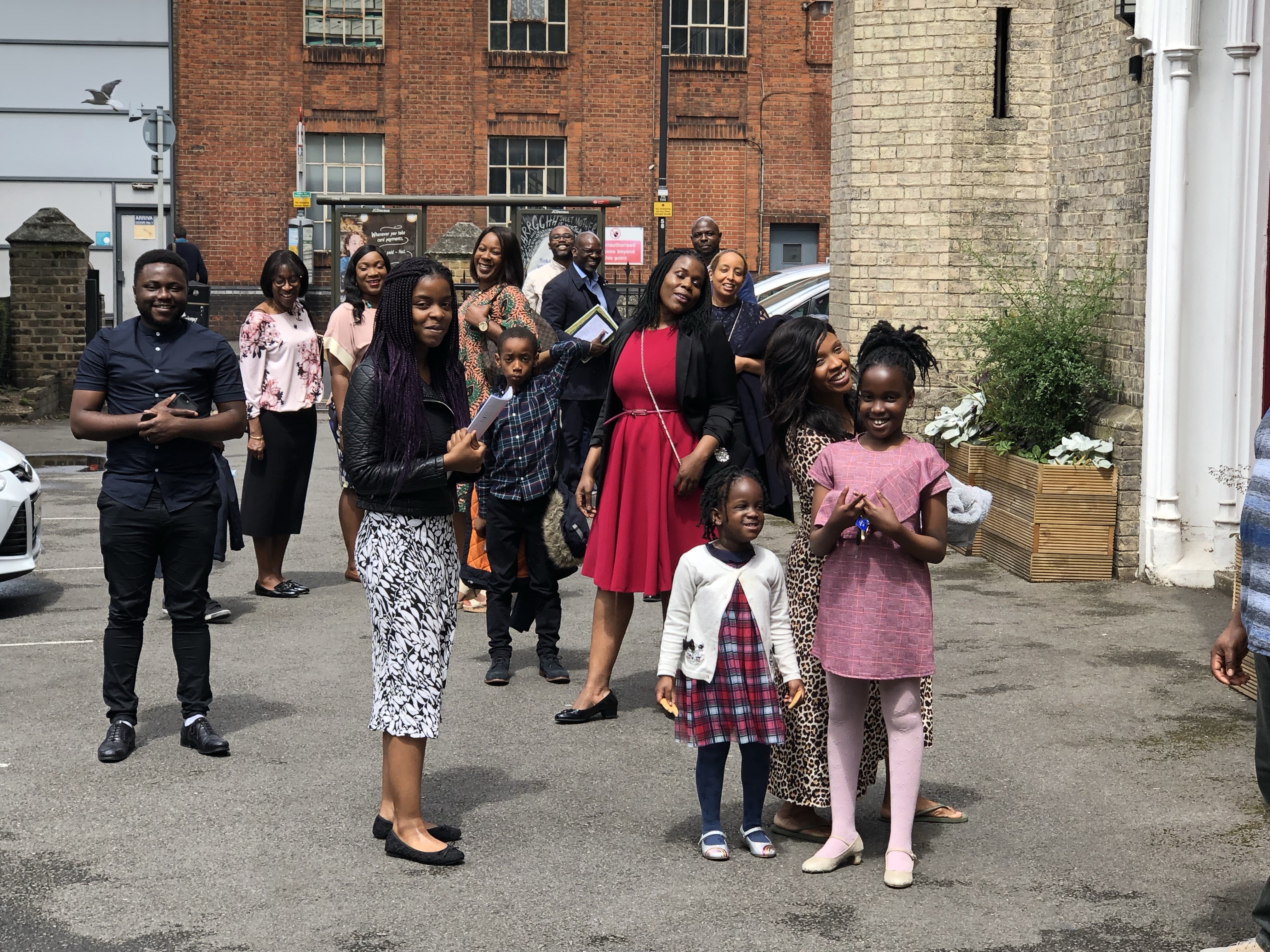
We have a Sunday school, which meets in the Church Hall, and a Youth Group with meets in the Old School on Sundays.
It is also worth noting that our church proved a space of relief and spiritual reflection for our parishioners and visitors to Tottenham during the 201I riots.
The church hall and old school are also used for a full range of community activities including a weekly Mothers’ Union run Foodbank.
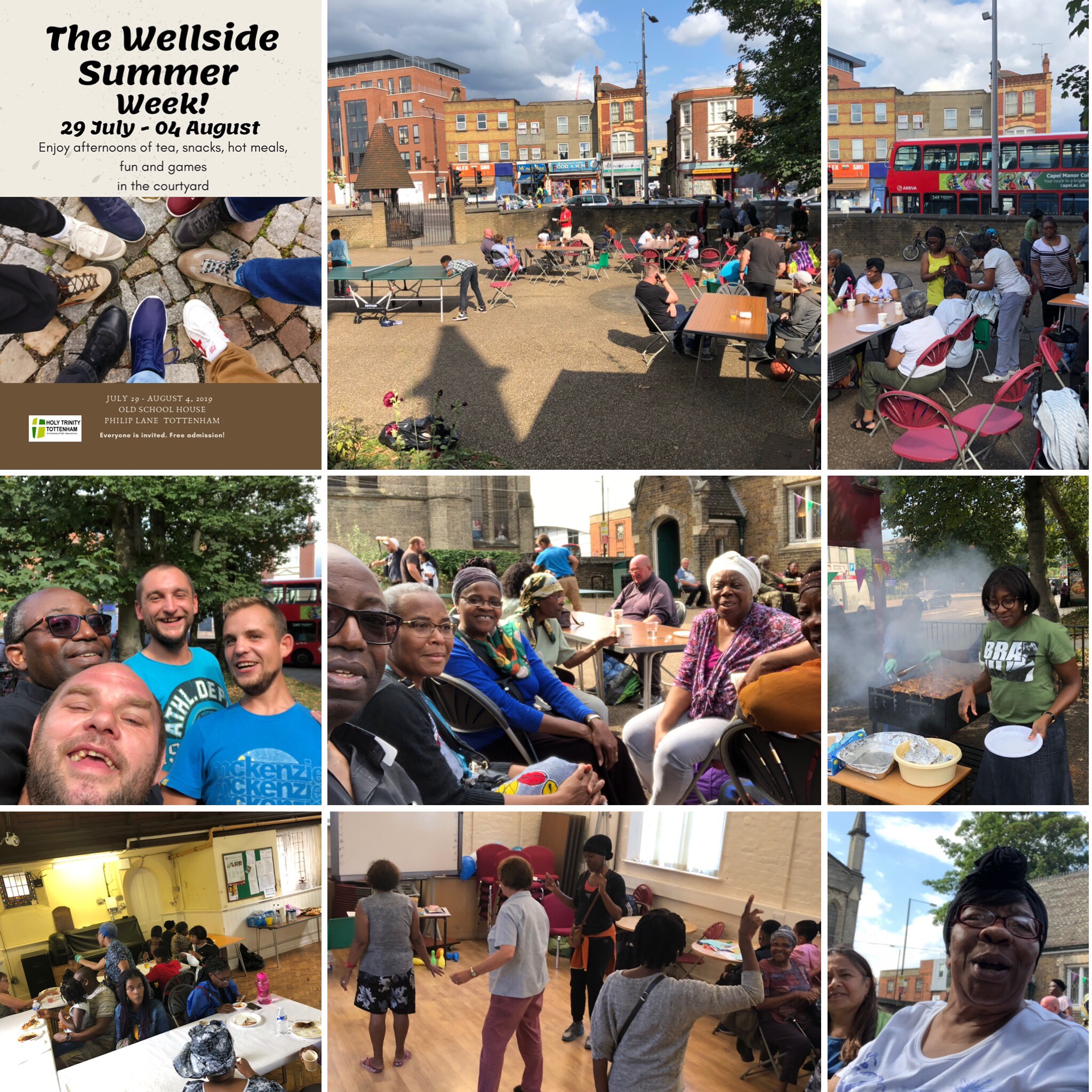
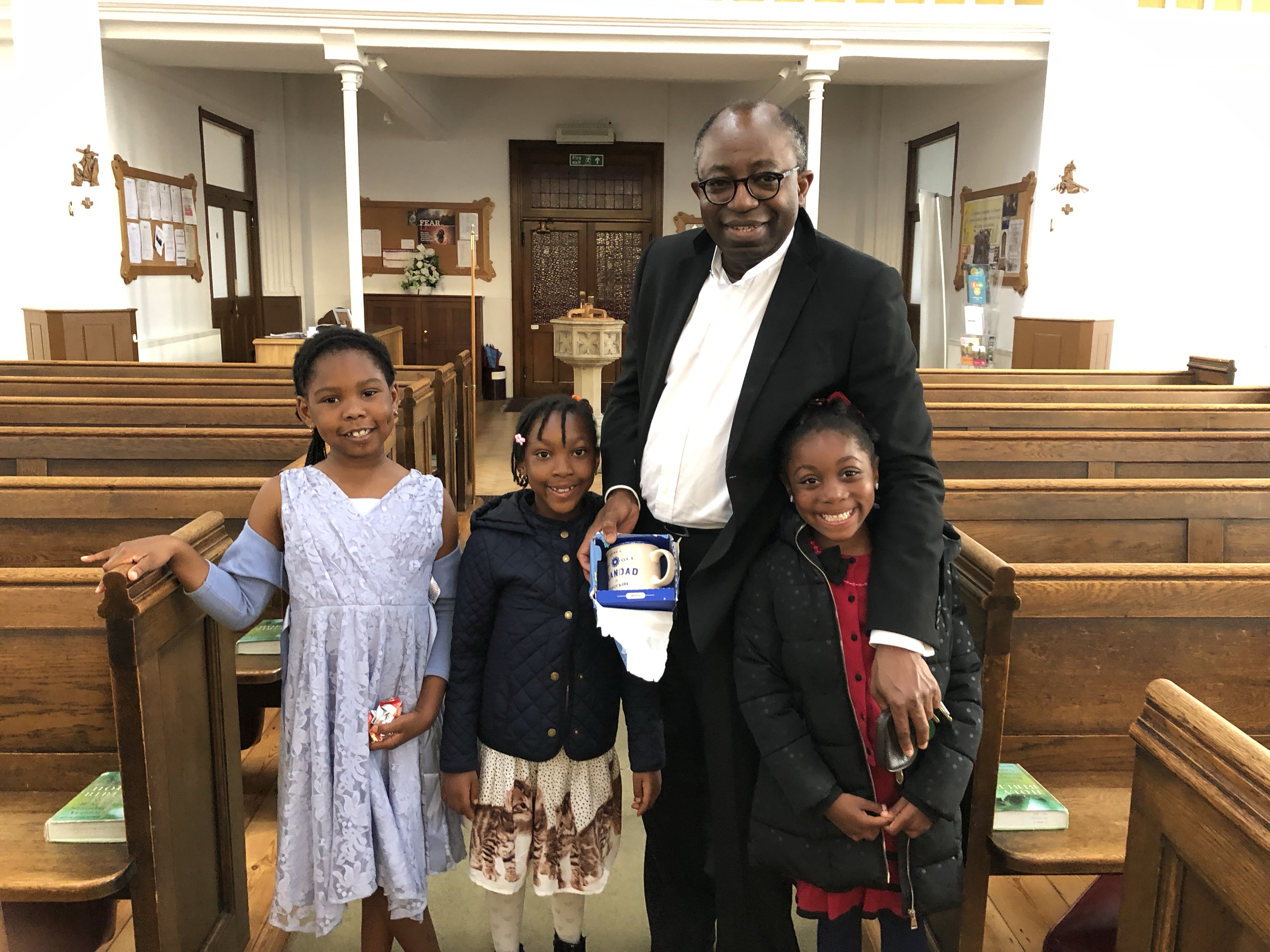
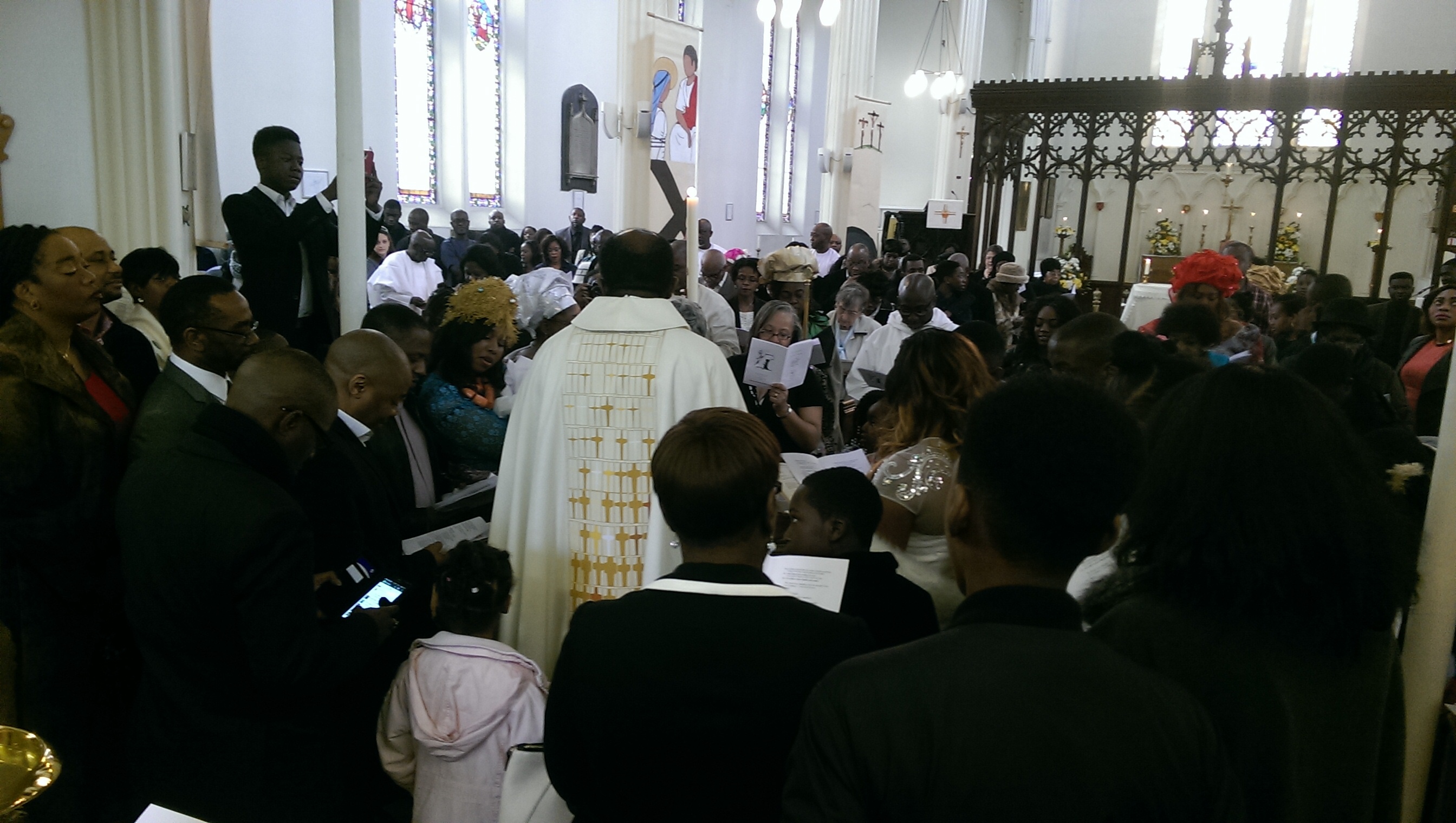

Footnote
* The Compleat Angler ends with the words,
“The Fifth Day
Piscator:Well, Scholar, I have almost tired myself, and, I fear more than almost tired you. But I now see Tottenham High-Cross, and our short walk thither shall put a period in my too long discourse; in which my meaning was, and is, to plant that in your mind with which I labour to possess my own soul; that is a meek and thankful heart. And to that end I have shewed you, that riches without them, do not make any man happy. But let me tell you, that riches with them remove many fears and cares. And therefore my advice is, that you endeavour to be honestly rich, or contentedly poor; but be sure that your riches be justly got, or you spoil all.”
Sources:
Bruce Castle Museum Archive
Bridget Cherry and Nikolaus Pevsner 1998: Buildings of England London 4: North
Dictionary of National Biography
F Fisk I923: History of Tottenham
William Robinson 1840: The History and antiquities of the parish of Totten- ham, in the county of Middlesex
W L Sumner 1957: Father Henry Willis Organ Builder and his successors Victorian County History (Middlesex)
Izack Walton 1653: The Compleat Angler
